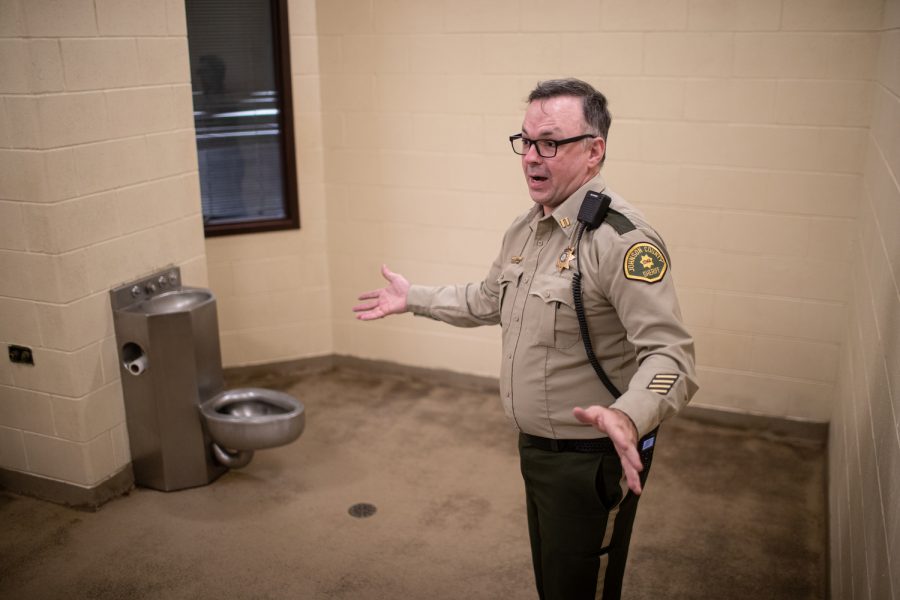Staff at the county sheriff’s office learn to adapt to the building’s poor condition
A recent facility audit of the sheriff’s office and jail showed that the building is in poor condition, and with space low, the staff there have learned to adapt as best as possible.
Captain John Good shows an overnight sobering cell during a tour of the Johnson County Sheriff’s Office on April 20, 2023. Good explained that sometimes multiple inmates at a time have to sleep on the floor.
April 26, 2023
When Johnson County contracted a company to complete a facility audit for all the county buildings, one of the results that stood out was the condition of the county sheriff’s office and jail.
The audit, completed by the company Faithful + Gould, assessed the condition of all county-owned properties. The worst of these buildings were three homes located on South Capitol and Prentiss Streets. The county had until recently been renting these buildings as apartments, and they will be demolished in the coming weeks.
But the sheriff’s office and jail stood out due to their importance and usage for the county. According to the assessment report, which was provided to The Daily Iowan, the two-story building would cost the county around $4.5 million to replace.
The report also stated that if the county chooses to undergo maintenance and repairs on the facility instead, it would cost $2.9 million over the next few years to address immediate needs.
Parts of this damage can be seen by looking at the building, including cracking of the bricks on the exterior of the building. A piece of metal on the exterior meant to support the bricks was visibly rusted and broken in one place, with the metal slightly hanging.
Johnson County Facilities Director Dave Curtis said the problem with the building is its need to be updated.
“There’s just numerous indications that the structure is suffering, not to mention the fact all the windows and the doors are all original to the building,” Curtis said. “So, they’re all, well, outdated, outlived their life. Anything you put in there would be an improvement in efficiency for energy.”
RELATED: Johnson County set to demolish county-owned houses located in Iowa City
The building was originally built in 1981, and despite a few updates in the following years, it remains in poor condition.
Curtis said the question became a matter of how much money should be put into restoring the condition of the building. An example he gave was the roof, which would cost roughly $240,000 to repair.
But the problem came from the fact that the roof had 22 air conditioning and heating units attached to it, all of which need to be updated. As a result, what started as a $240,000 project became a $2 million project.
Johnson County Sheriff Brad Kunkel provided another example of the building’s condition. He said when he first joined the sheriff’s office 20 years ago, there had been water and sewer pipe problems, an issue that has continued to this day.
“I know 20 years ago, we had a local company come in, and they did some work on the water and sewer pipes, and here within the last year or two, that same company is now back in doing more of the same work,” Kunkel said.
Kunkel said problems with the pipes meant there were sometimes leaks on the ceiling tiles of the first-floor staff office space.
It’s unknown how the county will approach the jail’s issue, although Curtis said the Johnson County Board of Supervisors had tasked him to form a capital planning committee that would address the needs of county-owned properties, including the jail.
To get a better perspective on the issue, the DI was allowed inside the building, and given a tour of the facility. It was led by Major Randy Lamm and Captain John Good of the sheriff’s office, with Curtis also accompanying.
The two explained that as the county had grown in size, so had the staff and the number of inmates at the jail and sheriff’s office. But when it was built, the sheriff’s office and jail had been built to hold a different capacity.
This includes the size of the actual cells of the jail, which were built at one size but then immediately became outdated as the requirement for cells increased a few years later. Because of how the building was built, it wasn’t possible to increase the size of any rooms on either floor.
The result was having a jail meant to have 46 beds now had to find space for 92 beds in the existing space. For sheriff’s employees, it was a similar problem of finding more space for the growing staff.
On the second floor, where the jail is located, the men showed that in different corners of the floor, makeshift storage areas had been created to keep items like laundry detergent and clothes. In one area, they even pointed out a part of the ceiling that was leaking, with the ceiling tile removed and buckets placed underneath to catch the water.
“We do the best we can with what we got, and it’s unfortunate that we have to deal with this,” Good said. “We don’t have the office space. We don’t have the space for the operation to run. We’re just trying to make it work within the walls.”



